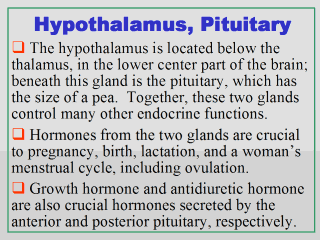| front |1 |2 |3 |4 |5 |6 |7 |8 |9 |10 |11 |12 |13 |14 |15 |16 |17 |18 |19 |20 |review |
 |
The
hypothalamus is located in the lower center part of the brain,
below the thalamus. This gland links
the nervous system to the endocrine network by producing hormones capable of
directing the anterior pituitary to release other hormones into the
circulatory system. The pituitary gland, located at the base of the
brain just beneath the hypothalamus, is no bigger than a pea. Together,
these two glands control many other endocrine functions. The pituitary gland
is often called the "master gland," and is structurally divided into the
anterior and the posterior lobe. The stimulation and the suppression of
hormone secretions from this master gland are regulated by factors released
by nerve cells (neurons) of the hypothalamus. The several hormone products secreted by the hypothalamus and the pituitary are very crucial to pregnancy, birth, lactation, and the menstrual cycle. These include the follicle-stimulating hormone (FSH) and the leutinizing hormone (LH). FSH stimulates the maturation of ovarian follicles, of which only one contains a mature egg. The release of this mature egg is induced by a large burst of LH secretion by the pituitary gland. The amounts of FSH and LH in the body vary throughout the menstrual cycle, and are highest just before ovulation. One critical hormone secreted by the anterior pituitary is growth hormone. Its major role is in stimulating the liver and other tissues to secrete the insulin-like growth factor IGF-1. This factor in turn is a major participant in the control of several complex physiologic processes, including growth and metabolism. Another important hormone, secreted by the posterior pituitary, is antidiuretic hormone (also known as vasopressin). The single most important role of this peptide hormone is in reducing the formation of urine to conserve body water. |